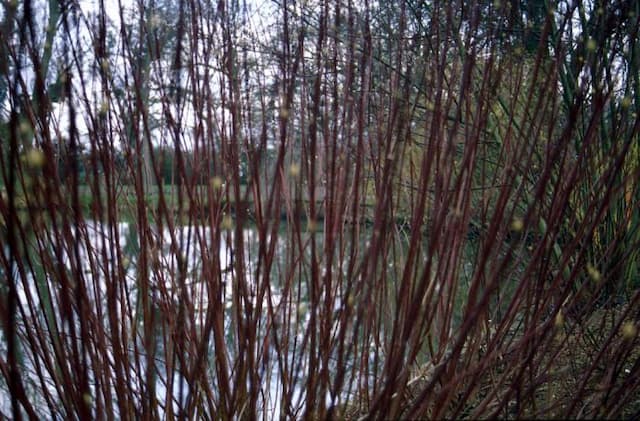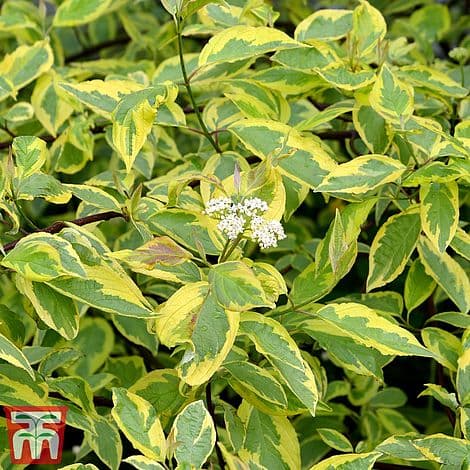Bloodtwig dogwood Cornus sanguinea 'Sifa' (PBR)











ABOUT
Cornus sanguinea 'Sifa', commonly known as Midwinter Fire dogwood, is a visually striking plant known for its distinctive and vivid coloration throughout the year. During the warmer seasons, it is adorned with lush green leaves that have an ovate shape with visible veins. The foliage provides a soft texture and a backdrop for the small clusters of white flowers that bloom in spring, which add a gentle contrast against the greenery. As the seasons transition to autumn, the Midwinter Fire dogwood's leaves transform into a fiery display of oranges, yellows, and reds, creating a warm and colorful tapestry that's reminiscent of a sunset blaze. This intense foliage coloration during the cooler months is one of its most notable features, offering a brilliant splash of color when many other plants have become dormant. Additionally, once the leaves fall, the stems reveal their true spectacle. They have a unique and striking appearance with colors that range from yellow at the base, transitioning to orange, and finally to a deep, vibrant red at the tips. This gradient of warm tones on the bare stems resembles flickering flames, hence the name Midwinter Fire. The contrast is particularly notable against a snowy backdrop or a stark winter landscape, making it a much-desired plant for winter interest in gardens. The overall shape of the Midwinter Fire dogwood is that of a rounded shrub, with branches elegantly arching outwards from the center. This architecture allows the stems and leaves to catch the light at various angles, enhancing the visual appeal throughout different times of the day and seasons. Interestingly, the small size and structure of this plant make it an ideal choice for smaller gardens, or as part of a border or mixed shrubbery in larger landscapes. Its vibrant color display and seasonal changes provide a dynamic feature, drawing the eyes of passersby and wildlife enthusiasts alike.
About this plant
 Names
NamesFamily
Cornaceae.
Synonyms
Midwinter Fire Dogwood, Bloodtwig Dogwood, Winter Flame, Winter Beauty.
Common names
Cornus sanguinea 'Sifa' (PBR).
 Toxicity
ToxicityTo humans
Cornus sanguinea, commonly known as Common Dogwood, is not widely recognized for being toxic to humans. However, as with many plants, it is generally advisable not to ingest any parts of the plant since the toxicity of specific cultivars like 'Sifa' can vary and there is limited information on their edible safety. Ingesting plant parts may potentially cause discomfort or an allergic reaction, but no specific symptoms of poisoning are well-documented for the Cornus sanguinea 'Sifa'.
To pets
For pets, particularly dogs and cats, the Common Dogwood (Cornus sanguinea 'Sifa') is similarly not well-known for being toxic. Nonetheless, it's prudent to prevent pets from ingesting this plant as individual sensitivity varies and not all potential reactions are fully understood. In general, animals consuming parts of the plant may experience gastrointestinal upset, including symptoms such as vomiting and diarrhea, if they have a sensitivity to it or consume large amounts.
 Characteristics
CharacteristicsLife cycle
Perennials
Foliage type
Deciduous
Color of leaves
Green
Flower color
White
Height
5 feet (1.52 meters)
Spread
5 feet (1.52 meters)
Plant type
Shrub
Hardiness zones
3-7
Native area
Europe
Benefits
 General Benefits
General Benefits- Ornamental Appeal: Cornus sanguinea, commonly known as Bloodtwig Dogwood, features striking red stems that add a splash of color to the landscape during winter when other plants may appear dormant.
- Seasonal Interest: This shrub provides year-round interest through its foliage, flowers, and stem color, with spring blossoms, summer berries, autumn leaves, and winter stem color.
- Habitat Support: Bloodtwig Dogwood produces berries that are a food source for birds and other wildlife, making it beneficial for maintaining local biodiversity.
- Erosion Control: The dense, fibrous root system of the Bloodtwig Dogwood is excellent for stabilizing soil and preventing erosion, especially on slopes.
- Low Maintenance: Once established, Bloodtwig Dogwood is easy to care for, requiring minimal attention other than occasional pruning to maintain its shape and promote healthy growth.
- Hardiness: This plant is hardy and can withstand cold temperatures, making it suitable for a variety of climates without extensive winter protection.
- Pollinator Friendly: The flowers of the Bloodtwig Dogwood are attractive to pollinators such as bees and butterflies, supporting these important species in the garden ecosystem.
 Medical Properties
Medical PropertiesThis plant is not used for medical purposes.
 Air-purifying Qualities
Air-purifying QualitiesThis plant is not specifically known for air purifying qualities.
 Other Uses
Other Uses- Ink Production: The bark of the Dogwood can be used to create a natural ink or dye due to its tannin content, which has historic significance for writing and artwork.
- Fishing Rods: Historically, the strong yet flexible stems of the Dogwood have been used to make fishing rods.
- Tool Handles: The dense and durable wood is ideal for creating handles for various tools, ensuring a comfortable grip and long-lasting use.
- Weaving Material: Young, flexible twigs of the Dogwood are sometimes used in traditional basketry and weaving crafts.
- Charcoal: Wood from the Dogwood can be burned to create a high-quality charcoal, desirable for artists and for use in gunpowder.
- Amateur Flute Crafting: The wood's fine grain and stability make it a suitable material for crafting musical instruments such as flutes by hobbyists.
- Wildlife Shelter: The dense branching pattern can provide shelter and nesting sites for birds and other small wildlife within a garden setting.
- Winter Interest: During the colder months, the striking red stems of the Dogwood provide aesthetic value to otherwise barren gardens.
- Slope Stabilization: The root system of Cornus sanguinea can help stabilize soil on slopes and prevent erosion.
- Photographic Subject: The Dogwood, especially when it exhibits its vibrant winter stem color, can be an inspiring subject for nature photographers.
Interesting Facts
 Feng Shui
Feng ShuiThe Bloodtwig Dogwood is not used in Feng Shui practice.
 Zodiac Sign Compitability
Zodiac Sign CompitabilityThe Bloodtwig Dogwood is not used in astrology practice.
 Plant Symbolism
Plant Symbolism- Stability: Cornus sanguinea, commonly known as Bloodtwig Dogwood or common dogwood, is a hardy shrub that symbolizes stability due to its sturdy nature and the strength it exhibits throughout the seasons.
- Vitality: The 'Sifa' cultivar, with its vibrant red stems that become more intense in winter, symbolizes vitality and the life force, particularly as it stands out during the coldest months when much of nature is dormant.
- Purity: Dogwoods are often associated with purity because of the characteristic shape and color of their flowers, which on many species appear like white or light-colored crosses.
- Resurrection: This symbolism ties to Christian lore, wherein the dogwood is associated with Easter and the resurrection of Christ, due to the cross-like shape of its flowers and the red, blood-like color on the tips of the petals in some species.
- Protection: Historically, the wood of the Cornus genus has been used to make tools and amulets, believed to ward off evil and offer protection.
 Water
WaterBloodtwig dogwood should be watered thoroughly, allowing the soil to be moist but not waterlogged. During the first growing season, it's important to establish a deep root system, so water it generously once a week, providing around 1 to 1.5 gallons per plant each time. Adjust the frequency to every two weeks once established, accounting for rainfall and soil condition. During hot, dry periods, water it twice a week to maintain moisture levels.
 Light
LightBloodtwig dogwood thrives best in full sun to partial shade. It's ideal to plant it in a spot where it can receive at least four to six hours of sunlight daily. However, it can also tolerate some afternoon shade, especially in hotter regions.
 Temperature
TemperatureThe ideal temperature range for Bloodtwig dogwood is between 50°F and 75°F. This plant can tolerate minimum winter temperatures down to around -30°F, making it suitable for hardiness zones 4 through 8. It withstands high temperatures as well, up to about 90°F, but it's important to provide ample watering during these warmer periods.
 Pruning
PruningPruning Bloodtwig dogwood is essential to encourage vibrant stem color and healthy growth. Pruning should be done in late winter or early spring before new growth starts. Cut back about a third of the oldest stems to ground level each year, which promotes new growth with brighter stem color. The best time for a more thorough pruning is after the plant has flowered, to shape the shrub and remove any damaged or diseased wood.
 Cleaning
CleaningAs needed
 Soil
SoilBloodtwig dogwood prefers well-draining soil with a mixture of two-thirds loam and one-third sand or perlite. It thrives best in soil with a pH range of 5.5 to 7.0 which is slightly acidic to neutral.
 Repotting
RepottingBloodtwig dogwoods are typically garden plants and do not require repotting. If grown in containers, repot every 2-3 years to refresh the soil and encourage growth.
 Humidity & Misting
Humidity & MistingThe optimal humidity level for Bloodtwig dogwood is moderate to high. It can tolerate a range of humidity conditions but does not thrive in extremely dry environments.
 Suitable locations
Suitable locationsIndoor
Ensure bright indirect light, moderate humidity, and cool temperatures.
Outdoor
Plant in full sun to partial shade with moist, fertile soil.
Hardiness zone
3-7 USDA
 Life cycle
Life cycleThe life cycle of Cornus sanguinea 'Sifa', commonly known as the Bloodtwig Dogwood, begins with seed germination, where conditions like moisture and temperature trigger the growth of a new plant. From germination, the seedling emerges and establishes itself, developing a root system and foliage. As it enters the vegetative stage, it grows stems, leaves, and branches, continuing to expand in size and forming its characteristic shape. The Bloodtwig Dogwood then enters the reproductive stage, producing clusters of small, white flowers which, upon successful pollination, lead to the development of small, blue-black fruits that are attractive to birds. After seed dispersal, which is often aided by wildlife, the plant enters a period of dormancy, particularly in colder climates, where it conserves energy during the winter. The cycle repeats annually with the return of spring promoting new growth and a return to the vegetative and reproductive stages.
 Propogation
PropogationPropogation time
Early spring
The most popular method for propagating Cornus sanguinea 'Sifa', commonly known as Bloodtwig Dogwood, is through softwood cuttings. During early summer, when the new growth is still tender and green, cuttings should be taken. Cut a 4- to 6-inch (about 10 to 15 cm) section of the stem, making sure it includes at least two sets of leaves. The bottom set of leaves should be removed and the cut end dipped in rooting hormone to encourage root development. The cutting should then be planted in a pot with well-draining potting mix, ensuring that at least one set of leaves remains above the surface. The pot needs to be kept in a warm, humid place with indirect light, and the soil should be kept consistently moist but not waterlogged. Roots typically develop within a few weeks, after which the new plant can eventually be transplanted outdoors.









